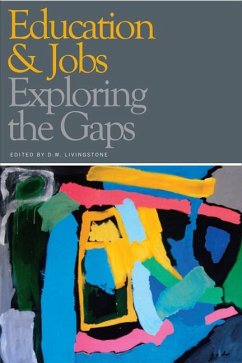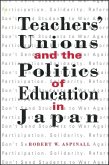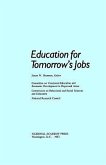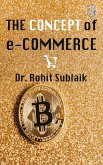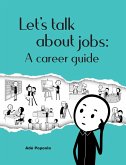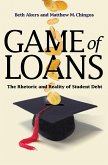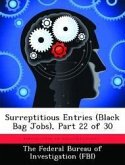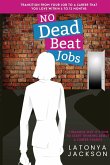Education & Jobs
Exploring the Gaps
Herausgeber: Livingstone, D W
Education & Jobs
Exploring the Gaps
Herausgeber: Livingstone, D W
- Broschiertes Buch
- Merkliste
- Auf die Merkliste
- Bewerten Bewerten
- Teilen
- Produkt teilen
- Produkterinnerung
- Produkterinnerung
"Edited by one of the world's leading educational sociologists, based on national survey data and close-focus case studies, this book makes a powerful case for new policy, industrial, and educational thinking." - Raewyn Connell, University of Sydney
Andere Kunden interessierten sich auch für
![Teachers' Unions and the Politics of Education in Japan Teachers' Unions and the Politics of Education in Japan]() Robert W AspinallTeachers' Unions and the Politics of Education in Japan39,99 €
Robert W AspinallTeachers' Unions and the Politics of Education in Japan39,99 €![Education for Tomorrow's Jobs Education for Tomorrow's Jobs]() National Research CouncilEducation for Tomorrow's Jobs50,99 €
National Research CouncilEducation for Tomorrow's Jobs50,99 €![The Concept of e-Commerce (Published by WKRISHIND) The Concept of e-Commerce (Published by WKRISHIND)]() Rohit SublaikThe Concept of e-Commerce (Published by WKRISHIND)25,99 €
Rohit SublaikThe Concept of e-Commerce (Published by WKRISHIND)25,99 €![Let's talk about jobs Let's talk about jobs]() Ade PopoolaLet's talk about jobs17,99 €
Ade PopoolaLet's talk about jobs17,99 €![Game of Loans Game of Loans]() Beth AkersGame of Loans20,99 €
Beth AkersGame of Loans20,99 €![Surreptitious Entries (Black Bag Jobs), Part 22 of 30 Surreptitious Entries (Black Bag Jobs), Part 22 of 30]() Surreptitious Entries (Black Bag Jobs), Part 22 of 3062,99 €
Surreptitious Entries (Black Bag Jobs), Part 22 of 3062,99 €![No Dead Beat Jobs No Dead Beat Jobs]() Latonya R JacksonNo Dead Beat Jobs19,99 €
Latonya R JacksonNo Dead Beat Jobs19,99 €-
-
-
"Edited by one of the world's leading educational sociologists, based on national survey data and close-focus case studies, this book makes a powerful case for new policy, industrial, and educational thinking." - Raewyn Connell, University of Sydney
Hinweis: Dieser Artikel kann nur an eine deutsche Lieferadresse ausgeliefert werden.
Hinweis: Dieser Artikel kann nur an eine deutsche Lieferadresse ausgeliefert werden.
Produktdetails
- Produktdetails
- Verlag: University of Toronto Press
- Seitenzahl: 384
- Erscheinungstermin: 1. September 2009
- Englisch
- Abmessung: 226mm x 150mm x 25mm
- Gewicht: 612g
- ISBN-13: 9781442600508
- ISBN-10: 1442600500
- Artikelnr.: 26822908
- Herstellerkennzeichnung
- Libri GmbH
- Europaallee 1
- 36244 Bad Hersfeld
- gpsr@libri.de
- Verlag: University of Toronto Press
- Seitenzahl: 384
- Erscheinungstermin: 1. September 2009
- Englisch
- Abmessung: 226mm x 150mm x 25mm
- Gewicht: 612g
- ISBN-13: 9781442600508
- ISBN-10: 1442600500
- Artikelnr.: 26822908
- Herstellerkennzeichnung
- Libri GmbH
- Europaallee 1
- 36244 Bad Hersfeld
- gpsr@libri.de
Edited by D.W. Livingstone
List of Tables and Graphs
Acknowledgements
Key Acronyms
Introduction, D.W. Livingstone
Part One: Prior Research Perspectives
1. Prior Concepts and Theories of the Relationship between Workers and
Jobs, D.W. Livingstone and K.V. Pankhurst
2. Prior Empirical Research on Education-Jobs Matching, D.W. Livingstone
3. Starting with The Education-Jobs Gap, D.W. Livingstone
Part Two: Surveying the Gaps
4. Education and Jobs Survey Profile I: National Trends in Employment
Conditions, Job Requirements, Workers' Learning and Matching, 1983-2004,
D.W. Livingstone and M. Raykov
5. Education and Jobs Survey Profile II: Employment Conditions, Job
Requirements, Workers' Learning and Matching, by Employee Class and
Specific Occupational Group, 2004, D.W. Livingstone and M. Raykov
Part Three: Exploring the Gaps: Case Studies
6. Elements of an Integrated Theory of Work and Learning, K.V. Pankhurst
7. Continual Learning, Autonomy, and Competency among High School Teachers,
M. Lordan
8. Staying Current in Computer Programming: The Importance of Informal
Learning and Task Discretion in Maintaining Job Competence, J. Weststar
9. Clerical Workers: Work and Learning in Fragmenting Workplaces, M. Radsma
10. Auto Workers' Learning in Lean Production, D.W. Livingstone and O.
Wilson
11. Struggling to Remain Employed: Learning Strategies of Workers with
Disabilities and the Education-Job Match, S. Officer
Part Four: Conclusions
12. The Relationship between Learning and Work: Empirical Evidence from the
Case Studies, K.V. Pankhurst
13. Education and Jobs: The Way Ahead, D.W. Livingstone and K.V. Pankhurst
Appendix 1: EJRM Case Study Interviewee Profiles
Appendix 2: Economic Class and Specific Occupational Group, by Intentional
Learning Activities, 2004
Bibliography
The Authors
Index
Acknowledgements
Key Acronyms
Introduction, D.W. Livingstone
Part One: Prior Research Perspectives
1. Prior Concepts and Theories of the Relationship between Workers and
Jobs, D.W. Livingstone and K.V. Pankhurst
2. Prior Empirical Research on Education-Jobs Matching, D.W. Livingstone
3. Starting with The Education-Jobs Gap, D.W. Livingstone
Part Two: Surveying the Gaps
4. Education and Jobs Survey Profile I: National Trends in Employment
Conditions, Job Requirements, Workers' Learning and Matching, 1983-2004,
D.W. Livingstone and M. Raykov
5. Education and Jobs Survey Profile II: Employment Conditions, Job
Requirements, Workers' Learning and Matching, by Employee Class and
Specific Occupational Group, 2004, D.W. Livingstone and M. Raykov
Part Three: Exploring the Gaps: Case Studies
6. Elements of an Integrated Theory of Work and Learning, K.V. Pankhurst
7. Continual Learning, Autonomy, and Competency among High School Teachers,
M. Lordan
8. Staying Current in Computer Programming: The Importance of Informal
Learning and Task Discretion in Maintaining Job Competence, J. Weststar
9. Clerical Workers: Work and Learning in Fragmenting Workplaces, M. Radsma
10. Auto Workers' Learning in Lean Production, D.W. Livingstone and O.
Wilson
11. Struggling to Remain Employed: Learning Strategies of Workers with
Disabilities and the Education-Job Match, S. Officer
Part Four: Conclusions
12. The Relationship between Learning and Work: Empirical Evidence from the
Case Studies, K.V. Pankhurst
13. Education and Jobs: The Way Ahead, D.W. Livingstone and K.V. Pankhurst
Appendix 1: EJRM Case Study Interviewee Profiles
Appendix 2: Economic Class and Specific Occupational Group, by Intentional
Learning Activities, 2004
Bibliography
The Authors
Index
List of Tables and Graphs
Acknowledgements
Key Acronyms
Introduction, D.W. Livingstone
Part One: Prior Research Perspectives
1. Prior Concepts and Theories of the Relationship between Workers and
Jobs, D.W. Livingstone and K.V. Pankhurst
2. Prior Empirical Research on Education-Jobs Matching, D.W. Livingstone
3. Starting with The Education-Jobs Gap, D.W. Livingstone
Part Two: Surveying the Gaps
4. Education and Jobs Survey Profile I: National Trends in Employment
Conditions, Job Requirements, Workers' Learning and Matching, 1983-2004,
D.W. Livingstone and M. Raykov
5. Education and Jobs Survey Profile II: Employment Conditions, Job
Requirements, Workers' Learning and Matching, by Employee Class and
Specific Occupational Group, 2004, D.W. Livingstone and M. Raykov
Part Three: Exploring the Gaps: Case Studies
6. Elements of an Integrated Theory of Work and Learning, K.V. Pankhurst
7. Continual Learning, Autonomy, and Competency among High School Teachers,
M. Lordan
8. Staying Current in Computer Programming: The Importance of Informal
Learning and Task Discretion in Maintaining Job Competence, J. Weststar
9. Clerical Workers: Work and Learning in Fragmenting Workplaces, M. Radsma
10. Auto Workers' Learning in Lean Production, D.W. Livingstone and O.
Wilson
11. Struggling to Remain Employed: Learning Strategies of Workers with
Disabilities and the Education-Job Match, S. Officer
Part Four: Conclusions
12. The Relationship between Learning and Work: Empirical Evidence from the
Case Studies, K.V. Pankhurst
13. Education and Jobs: The Way Ahead, D.W. Livingstone and K.V. Pankhurst
Appendix 1: EJRM Case Study Interviewee Profiles
Appendix 2: Economic Class and Specific Occupational Group, by Intentional
Learning Activities, 2004
Bibliography
The Authors
Index
Acknowledgements
Key Acronyms
Introduction, D.W. Livingstone
Part One: Prior Research Perspectives
1. Prior Concepts and Theories of the Relationship between Workers and
Jobs, D.W. Livingstone and K.V. Pankhurst
2. Prior Empirical Research on Education-Jobs Matching, D.W. Livingstone
3. Starting with The Education-Jobs Gap, D.W. Livingstone
Part Two: Surveying the Gaps
4. Education and Jobs Survey Profile I: National Trends in Employment
Conditions, Job Requirements, Workers' Learning and Matching, 1983-2004,
D.W. Livingstone and M. Raykov
5. Education and Jobs Survey Profile II: Employment Conditions, Job
Requirements, Workers' Learning and Matching, by Employee Class and
Specific Occupational Group, 2004, D.W. Livingstone and M. Raykov
Part Three: Exploring the Gaps: Case Studies
6. Elements of an Integrated Theory of Work and Learning, K.V. Pankhurst
7. Continual Learning, Autonomy, and Competency among High School Teachers,
M. Lordan
8. Staying Current in Computer Programming: The Importance of Informal
Learning and Task Discretion in Maintaining Job Competence, J. Weststar
9. Clerical Workers: Work and Learning in Fragmenting Workplaces, M. Radsma
10. Auto Workers' Learning in Lean Production, D.W. Livingstone and O.
Wilson
11. Struggling to Remain Employed: Learning Strategies of Workers with
Disabilities and the Education-Job Match, S. Officer
Part Four: Conclusions
12. The Relationship between Learning and Work: Empirical Evidence from the
Case Studies, K.V. Pankhurst
13. Education and Jobs: The Way Ahead, D.W. Livingstone and K.V. Pankhurst
Appendix 1: EJRM Case Study Interviewee Profiles
Appendix 2: Economic Class and Specific Occupational Group, by Intentional
Learning Activities, 2004
Bibliography
The Authors
Index

